
The May Company Ohio was a chain of department stores that was based in Cleveland, Ohio, United States.
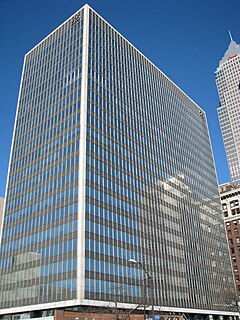
55 Public Square is a 22-story skyscraper located at number 55 Public Square, the town square of downtown Cleveland, Ohio. Designed by Carson Lundin & Shaw Architects, it is 300 feet tall, was completed in 1958, and was the first new skyscraper built in Cleveland since the Terminal Tower complex was completed in 1930. It was also the first tall International Style building in the city and the first to use a reinforced concrete frame. The consulate general of Slovenia is located in the building.
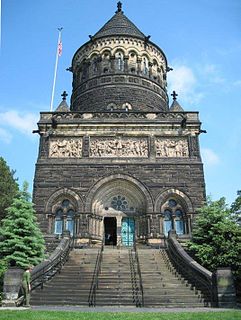
The James A. Garfield Memorial is a memorial dedicated to assassinated President James A. Garfield and located in Lake View Cemetery in Cleveland, Ohio, in the United States. The memorial, built from is a combination of Byzantine, Gothic, and Romanesque Revival styles, began construction in October 1885 and was dedicated on May 30, 1890. Garfield; his wife, former First Lady Lucretia Garfield; and two other members of the Garfield family are entombed in the crypt level of the monument.

Lake View Cemetery is a privately owned, nonprofit garden cemetery located in the cities of Cleveland, Cleveland Heights, and East Cleveland in the U.S. state of Ohio. Founded in 1869, the cemetery was favored by wealthy families during the Gilded Age, and today the cemetery is known for its numerous lavish funerary monuments and mausoleums. The extensive early monument building at Lake View helped give rise to the Little Italy neighborhood, but over-expansion nearly bankrupted the burial ground in 1888. Financial recovery only began in 1893, and took several years. Lake View grew and modernized significantly from 1896 to 1915 under the leadership of president Henry R. Hatch. The cemetery's cautious management allowed it to avoid retrenchment and financial problems during the Great Depression.
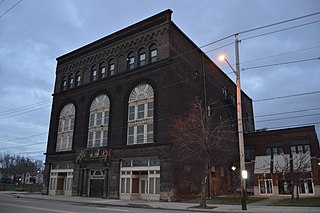
Bohemian National Hall is an historic building located in Cleveland, Ohio, that was built in 1896. It was listed on the National Register of Historic Places on May 28, 1975. The hall was built to serve the cultural and educational needs of the Czech immigrant community, and currently serves as host to Sokol Greater Cleveland and the Cleveland Czech Cultural Center and Museum.

The Citizens Building is a high-rise office and retail building located at 840 Euclid Avenue in Cleveland, Ohio, in the United States. The structure was built in 1903 by the Citizens Savings and Trust, a local bank. Its entrance portico was removed in 1924, and a two-story addition erected in its place. Home to the City Club of Cleveland since 1982, the building was renamed the City Club Building in 1999.

St. Josaphat Ukrainian Catholic Cathedral is a Ukrainian Catholic cathedral located in Parma, Ohio, in the United States. The cathedral grew out of a parochial school which opened in 1951 and a parish erected in 1959. Construction on the cathedral began in 1982, and was completed in 1985. It was dedicated in 1988, the thousand-year anniversary of the arrival of Christianity in Ukraine. The cathedral is the seat for the Ukrainian Catholic Eparchy of Saint Josaphat in Parma, which was erected in 1983 during construction of the building.

The Garfield Building is a high-rise building on the corner of Euclid Avenue and E. 6th Street in Cleveland, Ohio, in the United States. It was the first steel frame skyscraper constructed in the city.

The Cleveland Trust Company Building is a 1907 building designed by George B. Post and located at the intersection of East 9th Street and Euclid Avenue in downtown Cleveland's Nine-Twelve District. The building is a mix of Beaux-Arts, Neoclassical, and Renaissance Revival architectural styles. It features a glass-enclosed rotunda, a tympanum sculpture, and interior murals.
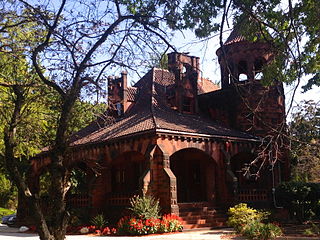
Riverside Cemetery Gatehouse is a historic office building located in Riverside Cemetery at 3607 Pearl Road in Cleveland, Ohio. It was completed in 1897, and added to the National Register of Historic Places in 1987. A significant interior renovation occurred about 1991 to 1992.
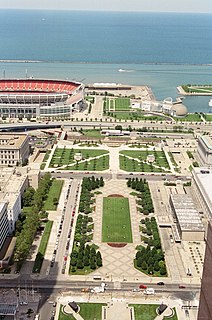
The Cleveland Convention Center was a convention center located in downtown Cleveland, Ohio, in the United States. Built by the city of Cleveland beneath the Cleveland Mall adjacent to Public Auditorium, it was completed in 1964. Plans for the convention center were first made in 1956, but voters twice rejected initiatives to fund construction before approving a bond levy in November 1963. A local private foundation donated several million dollars to beautify the mall atop the convention center with a reflecting pool and fountains.
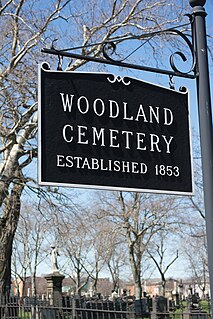
Woodland Cemetery is a historic rural cemetery located at 6901 Woodland Avenue in Cleveland, Ohio. Established in 1853, it became Cleveland's main public cemetery after its founding and remained so for the next half-century. It fell into extreme disrepair, and most of its outstanding architectural features dismantled or demolished. In 1986, Woodland Cemetery was added to the National Register of Historic Places. The cemetery has since undergone restoration.

The Baker Motor Vehicle Company Building, also known as the Baker Electric Building, is a historic commercial building in Cleveland, Ohio, in the United States. Built in 1910, it was the first showroom of the Baker Electric Motor Car Co., a pioneer in Brass Era electric automobiles. Baker Electric merged with Rauch and Lang in 1914, and the building was sold in 1920. It served as an auto dealership, machine shop, and print shop for the next 86 years. The structure underwent a two-year renovation and historic preservation from 2006 and 2008, and now serves as a startup business incubator.

The H. Black and Company Building is a historic former factory building located in Cleveland, Ohio, in the United States. It was commissioned by H. Black and Company, one of the largest manufacturers of women's clothing in the United States, and designed by noted New York City architect Robert D. Kohn. Completed in 1907, it won national praise for its design. The building was sold in 1928 to the Evangelical Press, and for a short time was known as the Evangelical Press Building. The commercial printing business of the Evangelical Press was spun off as a secular company, Tower Press, in 1934, after which the structure became known as the Tower Press Building. Vacant for much of the 1960s and 1970s, the building had two different owners in the 1980s and was nearly demolished. A new owner took over the building in 2000, after which it underwent an award-winning renovation and restoration. The structure was added to the National Register of Historic Places on January 24, 2002. The structure now serves as a mixed-use development for low- and moderate-income artists.
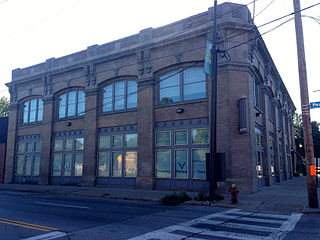
The Brooklyn Bank Building is a historic bank structure located in Cleveland, Ohio, in the United States. Designed in 1904 by noted Cleveland architect J. Milton Dyer as a home for the Brooklyn Savings and Loan Association, the building exhibits a mix of architectural styles, including Neoclassical and Commercial, typical of Dyer's eclectic work.

The Brownell School and Annex are three historic former public school buildings located on Sumner Street in Cleveland, Ohio, in the United States. The Queen Anne-style main building was designed by prominent local architect John Eisenmann, and erected from 1884 to 1885. The first annex was designed by noted local architect Frank Seymour Barnum, and completed in 1905. The second annex, also by Barnum, was finished in 1909. Several individuals of local and national importance were educated there or taught school there, and the building served as the first campus of Cuyahoga Community College in 1962. The building was sold to private owners in 1979, and the complex underwent a major renovation from 1983 to 1985.
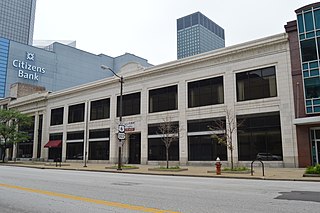
The Bryant Building is a historic retail building located in Cleveland, Ohio, in the United States. The building, designed by the prominent local architectural firm of Christian, Schwarzenburg and Gaede, was constructed by Mall Motor Co. as their new salesroom and service center, and was completed in 1921. The structure was purchased by Bryant Motor Co. in 1922.

The Cedar Glen Apartments are a historic apartment building located in the University Circle neighborhood of Cleveland, Ohio, in the United States. Designed by prominent local architect Samuel H. Weis and completed in 1927, the building originally contained luxury apartments and served as a gateway to the more exclusive neighborhood of Cleveland Heights, on whose border the building is located. Threatened with demolition in 1992, the building was purchased by new owners and converted into condominiums.

The Valley Railway was a shortline railroad which operated between the city of Cleveland and small town of Zoarville in the state of Ohio in the United States. The railroad was founded in 1871, but the first segment of track did not open until 1880 and the line was not completed until 1884. The Baltimore and Ohio Railroad (B&O) obtained a controlling interest in the Valley Railway in 1890. The railroad went bankrupt in 1895, at which time it was reorganized as the Cleveland, Terminal and Valley Railway (CT&V). The B&O took over operation of the CT&V in 1909, and the company was merged with the B&O in 1915.
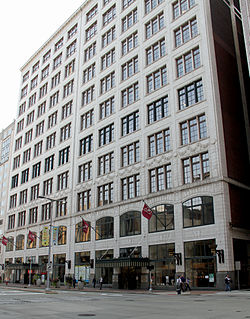
The Halle Building, formerly known as the Pope Building and after 2014 as The Residences at Halle, is an 11-story Chicago School mixed-use structure located in the Downtown Cleveland central business district in Cleveland, Ohio, in the United States. Designed by architect Henry Bacon, the building was the flagship department store of the Halle Brothers Co. from 1910 to 1982.

























